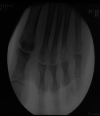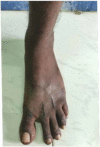Rare Case Report of Closed Traumatic Dislocation of Second to Fifth Metatarsophalangeal Joints
- PMID: 33403175
- PMCID: PMC7773289
- DOI: 10.7759/cureus.11745
Rare Case Report of Closed Traumatic Dislocation of Second to Fifth Metatarsophalangeal Joints
Abstract
Closed traumatic dislocation of multiple metatarsophalangeal joints is a rare injury. Until now only one case of simultaneous dislocation of all five metatarsophalangeal joints has been reported in peer-reviewed studies. The complex anatomy of the metatarsophalangeal joints prevents the relocation of the joints in a closed manner in maximum cases. We are reporting a case of dorsal dislocation of the second to fifth metatarsophalangeal joints in the left foot after road traffic accident. Bony prominence over the plantar aspect and increased web space between toes on presentation, then incongruity of metatarsophalangeal joints has to be thoroughly checked on radiograph. Since closed reduction attempts failed open reduction was done through dorsal approach using two incisions. Button holing of the capsule with interposition of capsule and plantar plate was noted. Dorsal approach avoids damage to the plantar plate and surrounding soft tissues.
Keywords: dorsal approach; foot and ankle; irreducible closed reduction; lesser mtp joints dislocation; no internal fixation; open reduction.
Copyright © 2020, Raj et al.
Conflict of interest statement
The authors have declared that no competing interests exist.
Figures








Similar articles
-
Open Reduction of 2nd Metatarsophalangeal Joint as a Method to Reduce Combined Lesser Metatarsophalangeal Dislocation - A Case Report.J Orthop Case Rep. 2024 Apr;14(4):110-114. doi: 10.13107/jocr.2024.v14.i04.4378. J Orthop Case Rep. 2024. PMID: 38681918 Free PMC article.
-
A Case of Simultaneous Traumatic Dorsal Dislocation of All Five Metatarsophalangeal Joints Treated Successfully With Closed Reduction.J Foot Ankle Surg. 2016 Mar-Apr;55(2):423-6. doi: 10.1053/j.jfas.2015.02.014. Epub 2015 Jun 12. J Foot Ankle Surg. 2016. PMID: 26074384
-
Irreducible metatarsophalangeal joint dislocation of the lesser toes: a case report.J Am Podiatr Med Assoc. 2013 May-Jun;103(3):236-40. doi: 10.7547/1030236. J Am Podiatr Med Assoc. 2013. PMID: 23697731
-
Another Classification of First Metatarsophalangeal Joint Dislocation-Type 3: Review and Case Description of the Plantar Dislocation.J Foot Ankle Surg. 2019 May;58(3):534-539. doi: 10.1053/j.jfas.2018.09.012. Epub 2019 Mar 20. J Foot Ankle Surg. 2019. PMID: 30902493 Review.
-
Rare Lateral Dislocation of the First Metatarsophalangeal Joint: A Case Report and Review of the Literature.J Foot Ankle Surg. 2017 Mar-Apr;56(2):375-378. doi: 10.1053/j.jfas.2016.11.006. Epub 2017 Jan 7. J Foot Ankle Surg. 2017. PMID: 28073653 Review.
Cited by
-
Open Reduction of 2nd Metatarsophalangeal Joint as a Method to Reduce Combined Lesser Metatarsophalangeal Dislocation - A Case Report.J Orthop Case Rep. 2024 Apr;14(4):110-114. doi: 10.13107/jocr.2024.v14.i04.4378. J Orthop Case Rep. 2024. PMID: 38681918 Free PMC article.
References
-
- A case of simultaneous traumatic dorsal dislocation of all five metatarsophalangeal joints treated successfully with closed reduction. Bhide PP, Anantharaman C, Mohan G, Raju K. J Foot Ankle Surg. 2016;55:423–426. - PubMed
-
- Traumatic dislocation of metatarsophalangeal joints: report of three different cases. De Palma L, Santucci A, Marinelli M. Foot Ankle Surg. 2001;7:229–234.
-
- Dislocation of all metatarsophalangeal joints caused by horse injury. Ito MM, Murase KI, Tanaka S, Yamashita T. J Trauma. 2007;63:938–939. - PubMed
-
- Irreducible dislocation of all the lesser metatarsophalangeal joints of the foot: a case report. Neogi DS, Bandekar SM, Sadekar V, Patnaik S, Bhat T, D’Mello Z. Foot Ankle Spec. 2012;5:324–326. - PubMed
-
- Presentation of a missed injury of a metatarsophalangeal joint dislocation in the lesser toes. Leung W, Wong S, Lam J, Ip F, Ko P. J Trauma. 2001;50:1150–1152. - PubMed
Publication types
LinkOut - more resources
Full Text Sources
